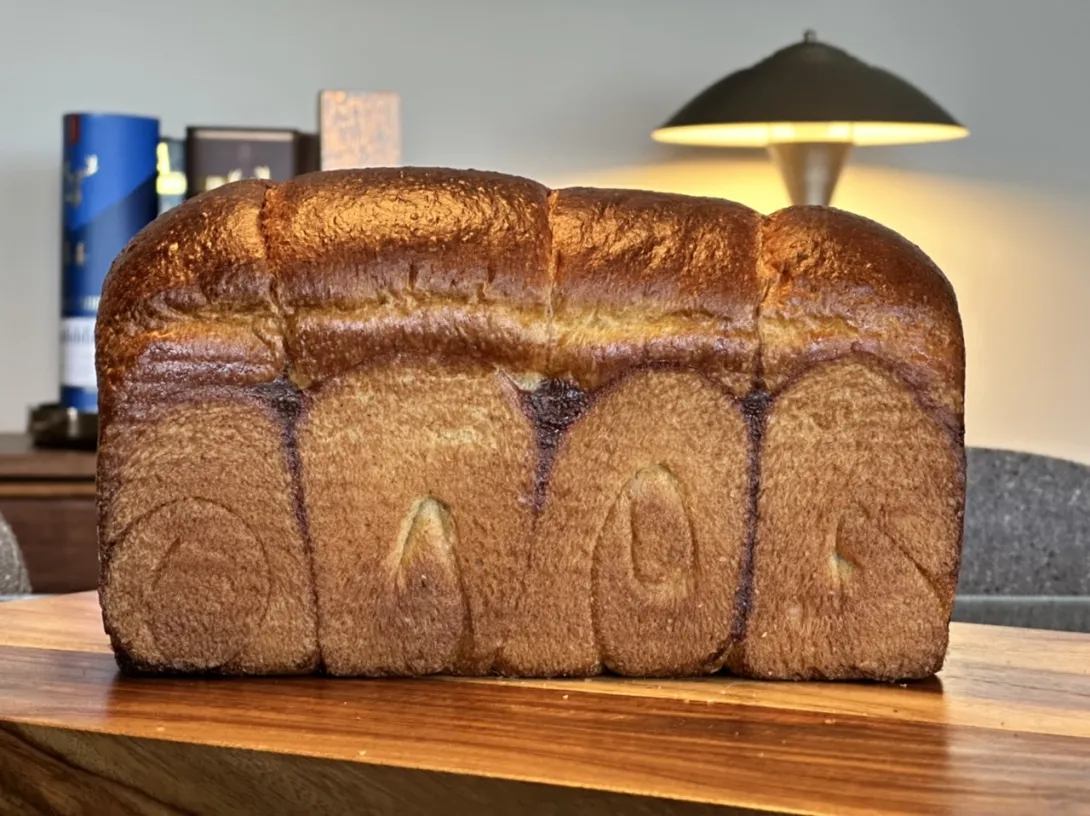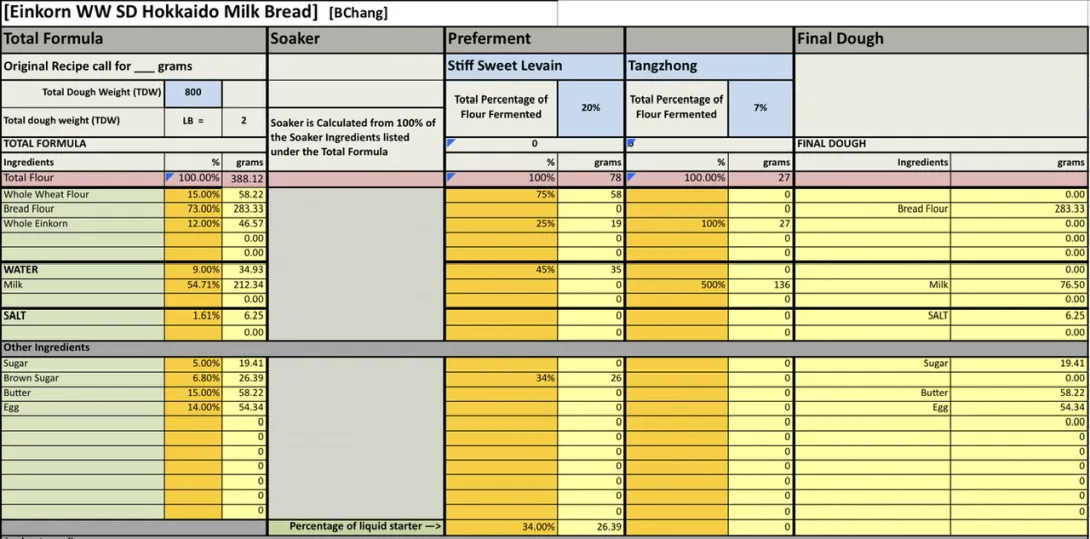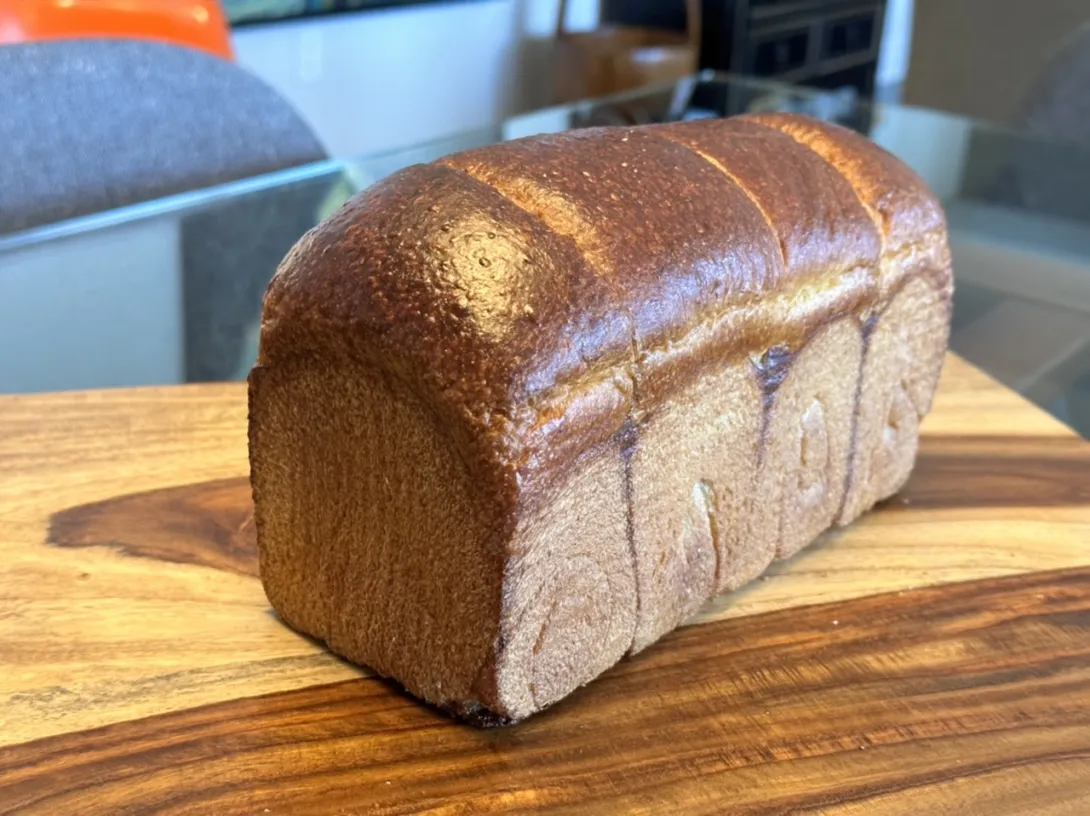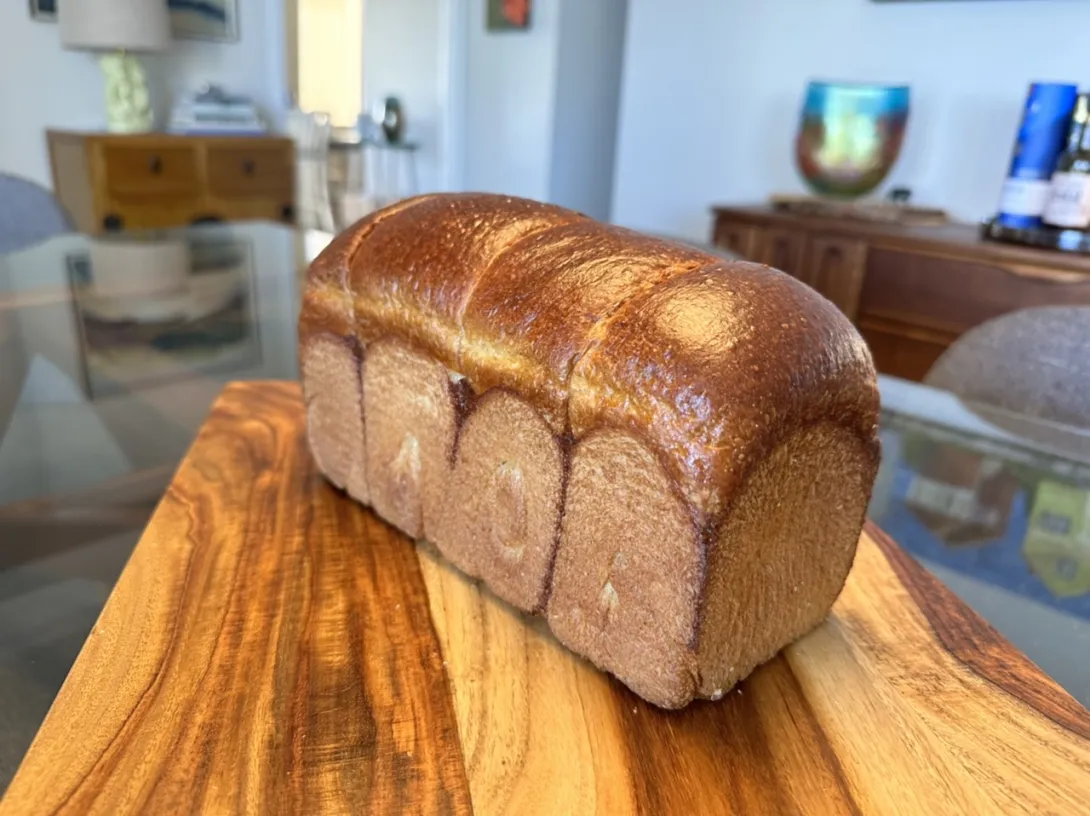I have a small quantity of whole einkorn that I need to use up before it goes bad. I decided I’d incorporate it into a milk bread with most of it being used in the tangzhong. I decided to do it this way because einkorn doesn’t have the best gluten so won’t add much to the structure of the dough. The rest of the einkorn goes into the stiff sweet levain along with all of the whole wheat. The rest of the flour is bread flour comprising 73% of the total flour.
To review, the idea of using a stiff sweet levain is that with sufficiently high sugar concentration, it will have a dehydrating effect on the microbes. This effect is greater on the LAB compared with the yeast. As a result, this levain is relatively deficient in LAB compared with a similar levain at the same hydration without the sugar. A bread leavened with this style of levain will generally have less sour tang unless it over ferments. I find that a Hokkaido milk bread is generally better without too much sour tang.
Unfortunately, this dough got away from me and over-fermented somewhat. We can see this with the loss of definition between the four lobes. Typically a well fermented bread with four lobes will have the appearance of four distinct “hills”. If one under-ferments this bread there will be a lot of tearing between the hills and they might be quite exaggerated. When over-fermented as this one was, you see a loss of definition of the hills.
Fortunately, this still baked up well and was extremely soft and fluffy.


For a 9”x4”x4” Pullman pan
Instructions
Levain
Mix the levain ingredients in a jar or pyrex container with space for at least 300% growth.
Press down with your knuckles or silicone spatula to create a uniform surface and to push out air.
At a temperature of 76-78ºF, it typically takes up to 10-12 hours for this sweet stiff levain to be at peak. For my starter I typically see 3-3.5 times increase in size at peak. The levain will smell sweet with only a mild tang.
Tangzhong
In a sauce pan set on medium heat, stir the milk and Whole Einkorn flour until blended. Then cook for several minutes until well thickened, stirring regularly with a spoon or heat-resistant spatula. Let cool in the pan or, for faster results, in a new bowl. Theoretically it should reach 65ºC (149ºF) but I don’t find I need to measure the temperature as the tangzhong gelatinizes at this temperature. You can prepare this the night before and refrigerate it, ensure that it is covered to prevent it from drying out.
If you plan on using a stand mixer to mix this dough, set up a Bain Marie and use your stand mixer’s bowl to prepare the tangzhong.
Dough
In the bowl of a stand mixer, add the milk (consider holding back 10 g of milk and adding later if this is the first time you’re making this), egg, tangzhong, salt, sugar and levain. Mix and then break up the levain into many smaller pieces. Next add the flours. I like to use my spatula to mix until there aren’t many dry areas. Allow the flour to hydrate (fermentolyse) for 20-30 minutes. Mix on low speed and then medium speed until moderate gluten development this may take 5-10 mins. You may want to scrape the sides of the bowl during the first 5 minutes of mixing. Next add room temperature butter one pat at a time. The dough may come apart, be patient, continue to mix until it comes together before adding in more butter. Once all the butter has been added and incorporated increase the speed gradually to medium. Mix at medium speed until the gluten is well developed, approximately 10 mins. You will want to check gluten development by windowpane during this time and stop mixing when you get a good windowpane. You should be able to pull a good windowpane, not quite as good as a white flour because the bran will interrupt the windowpane somewhat.
On the counter, shape the dough into a tight ball, cover in the bowl and ferment for 2 - 3 hours at 82ºF. There should be some rise visible at this stage.
You can next place the dough into the fridge to chill the dough for about 1.5 hours, this makes rolling the dough easier to shape. Remember, if you do so the final proof will take longer. Alternatively, you can do a cold retard in the fridge overnight, however, you may find that this increases the tang in your bread.
Prepare your pans by greasing them with butter or line with parchment paper.
Lightly flour the top of the dough. Scrape the dough out onto a clean counter top and divide it into four. I like to weigh them to have equal sized lobes. Shape each tightly into a boule, allow to rest 5 mins. Using a rolling pin roll each ball out and then letterfold. Turn 90* and using a rolling pin roll each out to at least 8”. Letterfold again from the sides so you have a long narrow dough. Then using a rolling pin, roll flatter but keeping the dough relatively narrow. The reason to do this extra letterfold is that the shorter fatter rolls when placed in the pan will not touch the sides of the pan. This allows the swirled ends to rise during final proof, this is only done for appearance sake and is not necessary. Next roll each into a tight roll with some tension. Arrange the rolls of dough inside your lined pan alternating the direction of the swirls. This should allow a greater rise during proof and in the oven.
Cover and let proof for 4-6 hours at a warm temperature. I proof at 82°F. You will need longer than 4-6 hours if you chilled your dough for shaping. I proof until the top of the dough comes to within 1 cm of the top edge of the pan.
Preheat the oven to 350F and brush the dough with the egg-milk wash. Just prior to baking brush with the egg-milk wash again.
Bake the loaves for 50 minutes or until the internal temperature is at least 190ºF, rotating as needed to get even browning. Shield your loaf if it gets brown early in the baking process. After 50 mins remove the bread from the pan and bake a further 10 mins by placing the loaf directly in the oven on the rack with the oven turned down to 325ºF. You can brush the top of the loaf with butter if you wish at this point while the bread is still hot to keep the top crust soft.


- Benito's Blog
- Log in or register to post comments
Here are the photos of the crumb.
Looks pretty great to me. I think most of us mere bread baking mortals would consider this one a win 😉.
Did you get any Eikorn flavor coming through? I’ve used it before and was not a big fan.
Best,
Ian
I actually like Einkorn is small amounts like this. it adds some complexity to the flavour of the bread without being overpowering.
Benny
Glad you are feeling better!!! I like Einkorn as well. I have flaked it and then toasted and made porridge with it and had very good success.
You definitely have Hokkaido down pat. c
Thank you Caroline, I do enjoy making these milk breads and they are perfect of sandwiches.
Benny
Looks like a great loaf and I agree with Ian. I’d be happy with that one! 😁
It certainly eats well. Thank you Tory and Ian.
Benny
And the shine is incredible! Very handsome loaf.
Thank you Mini, good ole egg wash will give you that shine every time.
Benny
Which ole egg wash did you use? I can think of several....whole egg, yolk, white, maybe combined with water, oil, or coffee, tea, or milk? :)
Good point, my standard egg wash is whole egg, some milk and a pinch of salt which will thin the whites.
Hey Benny,
I'm excited to try to use your sweet stiff levain to adapt one of my favorite babka recipes from yeast to sourdough.
Question for you, and sorry if this is obvious: is the "% of liquid start" the amount of 100% hydration starter you use to create your sweet stiff levain? This seems to fit if using bakers % with the total flour in the sweet leavin as 100%, but wanted to double check. Thanks for your help!
Sorry it isn’t more obvious, but yes you’re correct the starter is a 100% hydration starter. I use a whole rye starter but you do you and use whatever starter you have at 100% hydration. Please post once you’ve baked this, I’d love your feedback.
Benny
Thanks Benny, I'll report back!
One final question: do you use all of the stiff levain that you build? It looks like that's 165g total.
As a baker's % this looked higher than I expected (42.5%), but then again I have almost no experience with naturally leavened enriched doughs; I'm usually baking country loaves, or sweets made with conventional yeast. Just wanted to be sure, thanks again for your help!
Yes I use all of the levain, 20% of the flour in this bake is pre-fermented, ie in the levain. Because it is an enriched dough it can be slow to ferment. What I’ve found is that the longer it takes to ferment this, the more the LAB will start to flourish and then make the dough more sour. To counteract that, I use a high % pre-fermented flour so it ferments more quickly to avoid the sour notes that the LAB will create.
Benny